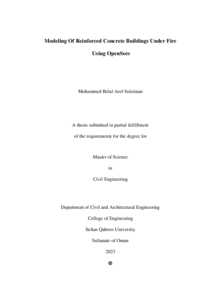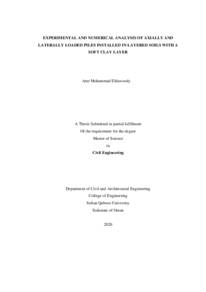Document
Modeling of reinforced concrete buildings under fire using OpenSees.
Source
Master's thesis
Country
Oman
City
Muscat
Publisher
Sultan Qaboos University
Gregorian
2023
Language
English
Thesis Type
Master's thesis
English abstract
Fire poses a significant and persistent threat to buildings, and events like the September
11 incident at the World Trade Center in 2001 have highlighted the need to
comprehend the behavior of structures under exposure to fire. Elevated temperatures
caused by fire induce additional thermal stresses and reduce material strength,
contributing to the potential failure of structural elements. To address these critical
concerns, this research aims to gain a comprehensive understanding of the behavior of
reinforced concrete buildings when subjected to various fire scenarios, different
element sections, and load ratio. A 2-story reinforced concrete building, that represents
a typical residential unit in Oman having a footprint of 13.91×22.5 meters, serves as
the subject for investigation. The study employs OpenSees for Fire, utilizing nonlinear static analysis, to model the buildings response to fire scenarios. To explore the
effects of different fire locations on the structures behavior under elevated
temperatures, three fire locations are distributed on each floor, yielding a total of 15
fire scenarios. On the ground floor and first floor, the fire locations are strategically
placed in three bays of sizes 5.3×3.6 meters, 4.4×4.1 meters, and 3.6×3.2 meters.
However, on the first floor, the second bay has a different dimension of 4.2×4.1 meters
due to changes in the layout. The ISO834 standard fire curve is applied as the thermal
load during the analysis. Additionally, the results are compared for both direct and
indirect effect conditions to comprehensively assess the structural response. Moreover,
to investigate the effects of weak and strong columns and beams the study first reduced
the beam sections by 0.5d and kept the columns as it is to have weak beams, after that
we increased the sections by 1.5d kept the columns as it is to have strong beams, and
the same thing has been done for the columns while the beams kept their original
sections. To see the effects of load first the study reduced the loads by 50% and after
that the load was increased by 150%. The study findings indicate that an increase in
temperature directly affects the internal forces and deformations experienced by the
beams and columns. This includes moments at spans and supports, axial forces, and
deflections. The location of the thermal loading significantly impacts the displacement
and bending moments in both spans and supports and the axial forces in spans. Closer
members to the thermal loading location exhibit higher internal forces. Additionally,
the thermal expansion of columns contributes to an upward displacement at the midpoint of the beams. The study also shows that increasing the depth of the elements
results in reduced displacement, movement, and axial force values. Conversely,
reducing the depth increases the displacement, moment, and axial force values.
Similarly, increasing the load of the elements increases the displacement, moment, and
axial force values, while reducing the load reduces the displacement, moment, and
axial force values. The results demonstrate that reinforced concrete structures display
remarkable strength under fire loads. Importantly, when structural elements are
positioned away from the fire, the effects of the fire become negligible. Understanding
the structural behavior under varying fire scenarios, load magnitude, and different
element sections is crucial to enhance fire safety measures and optimizing the
structural design to withstand potential fire hazards.
Arabic abstract
تشكل الحرائق تهديدا 11كبيرا ومستمرا للمباني، وأبرزت أحداث مثل الحادث الذي وقع في 11 أيلول/سبتمبر في مركز التجارة العالمي في عام 2001 الحاجة إلى فهم سلوك الهياكل المعرضة للنيران. وتتسبب درجات الحرارة المرتفعة الناجمة عن الحرائق في حدوث ضغوط حرارية إضافية وتخفض من قوة المواد، مما يسهم في احتمال فشل العناصر الهيكلية. ولمعالجة هذه الشواغل الحاسمة، يهدف هذا البحث إلى اكتساب فهم شامل لسلوك المباني الخرسانية المعززة عندما تخضع لسيناريوهات حريق مختلفة، وأقسام عناصر مختلفة، ونسبة الحمل. ويشكل بناء خرساني معزز من طابقين، يمثل وحدة سكنية نموذجية في ُعمان يبلغ بُعدها 13.91×22.5 متر، موضوعاً للتحقيق. وتستخدم الدراسةOpenSees ، باستخدام التحليل الثابت غير الخطي، لنموذج استجابة المبنى لسيناريوهات الحريق. والستكشاف آثر أختالف مواقع الحرائق على سلوك الهيكل تحت درجات حرارة مرتفعة، توزع ثالثة مواقع حريق على كل طابق، مما أسفر عن ما مجموعه 15 سيناريو حريق. في الطابق األرضي والطابق األول، توضع مواقع الحرائق استراتيجيا (Bay (من األحجام: 5.3×3.6 متر، و4.4×4.1 ً في ثالثة متر، و3.6×3.2 متر. ومع ذلك، في الطابق األول، لل (bay (الثاني بعد مختلف 4.2×4.1 متر بسبب التغيرات في التصميم. ويطبق منحنى النار المعياري 834ISO كحمولة حرارية أثناء التحليل. عالوة على ذلك، لدراسة تأثير األعمدة والكمرات الضعيفة والقوية قامت الدراسة أوالً 0.5 د وإبقاء األعمدة كما بتقليل مقاطع العتبة بمقدار هي لتكون ذات كمرات ضعيفة، بعد ذلك قمنا بزيادة المقاطع بمقدار 1.5 د وحافظت على األعمدة كما هي. أن تكون العوارض قوية، وتم عمل نفس الشيء بالنسبة لألعمدة مع احتفاظ الكمرات بأجزاءها األصلية. لمعرفة تأثيرات األحمال أوالً قامت الدراسة بتقليل األحمال بنسبة %50 وبعد ذلك تم زيادة األحمال بنسبة .%150 تكشف نتائج الدراسة عن وجود ارتباط مباشر بين ارتفاع درجة الحرارة والقوى الداخلية والتشوهات التي تعاني منها وعالوة على ذلك، فإن موقع التحميل الحراري يؤثر تأثيراً كبيراً للكمرات والأعمدة المتأثرة. على ال )displacement )إذ ينحني اللحظات في كل من المسافات والدعائم، فضالً عن القوى المحورية في المسافات. ومن الجدير بالمالحظة أن األعضاء الذين يقعون بالقرب من موقع التحميل الحراري يظهرون قوى داخلية أعلى. وعالوة على ذلك، فإن التوسع الحراري لألعمدة يسهم في حدوث نزوح تصاعدي يالحظ عند نقطة وسط الكمرات. أن زيادة عمق العناصر من شأنه أن يقلل من وتبين الدراسة أيضا )اإلزاحة والعزم والقوة المحورية( بينما التقليل ً من العمق سيزيد من قيم ال )الإزاحة والعزم والقوة المحورية( كما أن زيادة عبء العناصر من شأنها أن تزيد من تلك القيم ومع تخفيض الحمل سيقلل من قيم ال )اإلزاحة والعزم والقوة المحورية(. وإجماال،ً تبين النتائج أن الهياكل الخرسانية المعززة تظهر قوة كبيرة تحت أحمال النيران. ومن المهم أنه عندما توضع عناصر هيكلية بعيدا عن النار، تصبح آثار الحريق ضئيلة. إن فهم السلوك الهيكلي في إطار سيناريوهات متفاوتة للحرائق، وحجم الحمل، ومختلف أقسام العناصر أمر بالغ األهمية لتعزيز تدابير السالمة من الحرائق وتحسين التصميم الهيكلي بحيث يصمد أمام المخاطر المحتملة للحرائق.
Category
Theses and Dissertations


